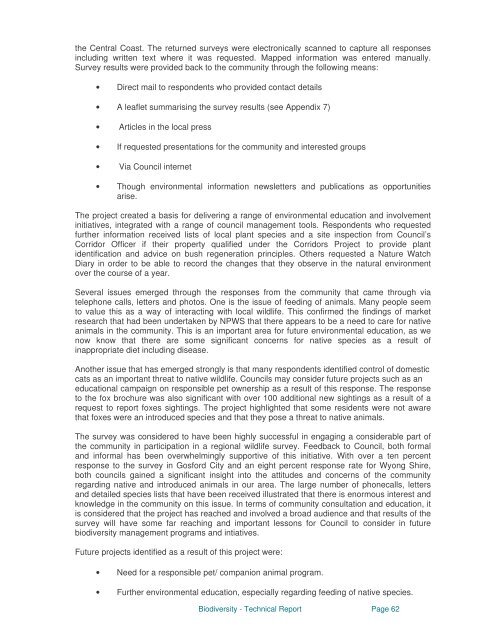Biodiversity Strategy - Gosford City Council - NSW Government
Biodiversity Strategy - Gosford City Council - NSW Government
Biodiversity Strategy - Gosford City Council - NSW Government
Create successful ePaper yourself
Turn your PDF publications into a flip-book with our unique Google optimized e-Paper software.
the Central Coast. The returned surveys were electronically scanned to capture all responses<br />
including written text where it was requested. Mapped information was entered manually.<br />
Survey results were provided back to the community through the following means:<br />
• Direct mail to respondents who provided contact details<br />
• A leaflet summarising the survey results (see Appendix 7)<br />
• Articles in the local press<br />
• If requested presentations for the community and interested groups<br />
• Via <strong>Council</strong> internet<br />
• Though environmental information newsletters and publications as opportunities<br />
arise.<br />
The project created a basis for delivering a range of environmental education and involvement<br />
initiatives, integrated with a range of council management tools. Respondents who requested<br />
further information received lists of local plant species and a site inspection from <strong>Council</strong>’s<br />
Corridor Officer if their property qualified under the Corridors Project to provide plant<br />
identification and advice on bush regeneration principles. Others requested a Nature Watch<br />
Diary in order to be able to record the changes that they observe in the natural environment<br />
over the course of a year.<br />
Several issues emerged through the responses from the community that came through via<br />
telephone calls, letters and photos. One is the issue of feeding of animals. Many people seem<br />
to value this as a way of interacting with local wildlife. This confirmed the findings of market<br />
research that had been undertaken by NPWS that there appears to be a need to care for native<br />
animals in the community. This is an important area for future environmental education, as we<br />
now know that there are some significant concerns for native species as a result of<br />
inappropriate diet including disease.<br />
Another issue that has emerged strongly is that many respondents identified control of domestic<br />
cats as an important threat to native wildlife. <strong>Council</strong>s may consider future projects such as an<br />
educational campaign on responsible pet ownership as a result of this response. The response<br />
to the fox brochure was also significant with over 100 additional new sightings as a result of a<br />
request to report foxes sightings. The project highlighted that some residents were not aware<br />
that foxes were an introduced species and that they pose a threat to native animals.<br />
The survey was considered to have been highly successful in engaging a considerable part of<br />
the community in participation in a regional wildlife survey. Feedback to <strong>Council</strong>, both formal<br />
and informal has been overwhelmingly supportive of this initiative. With over a ten percent<br />
response to the survey in <strong>Gosford</strong> <strong>City</strong> and an eight percent response rate for Wyong Shire,<br />
both councils gained a significant insight into the attitudes and concerns of the community<br />
regarding native and introduced animals in our area. The large number of phonecalls, letters<br />
and detailed species lists that have been received illustrated that there is enormous interest and<br />
knowledge in the community on this issue. In terms of community consultation and education, it<br />
is considered that the project has reached and involved a broad audience and that results of the<br />
survey will have some far reaching and important lessons for <strong>Council</strong> to consider in future<br />
biodiversity management programs and intiatives.<br />
Future projects identified as a result of this project were:<br />
• Need for a responsible pet/ companion animal program.<br />
• Further environmental education, especially regarding feeding of native species.<br />
<strong>Biodiversity</strong> - Technical Report Page 62
















